TV animal programs:
Loinclothed Animals
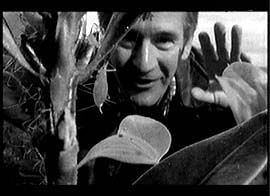
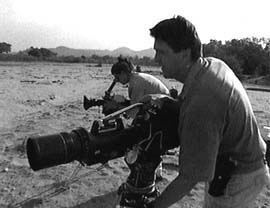
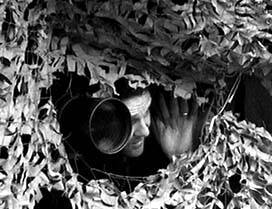
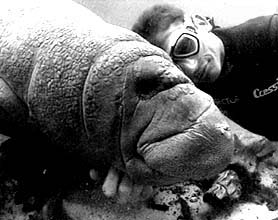
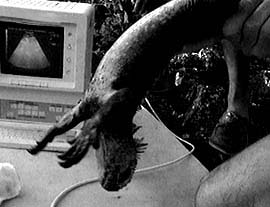

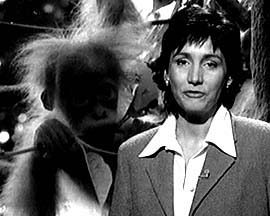
Before our very eyes, the reporter latches on to Mother Nature in all her virginity, applying his expertise, language skills and a special camera to the task. He describes nature as a stage for Thor epitomized, the animal figure. Film editing spurs the animals into action, for their pastime of rolling around hardly makes a gripping film. Shown instead are the good and the bad times, accelerated life scenes featuring breathtaking appear ances (opener) and exits (cut), silver-backed mating scenes, wild boars or (cutaway) a wild sow with tail aloft.
No stage this, but a media-focused autopsy table. Stage play and feature films think up a tissue of dramatic moments, while wildlife documentaries edit such moments out from the animals' drowsy existence, as if extracting muscle fiber from adipose tissue. Acquired by appropriating the very hunting tactics of the beasts of prey as they position themselves leeward, these instants are then filtered, rectified and built up into a montage.
Now the learned guide inserts his miniaturized camera up nature's rectum, taking us along on a wonderful journey to the heart of Africa and its foreign pulse. Sweeping past iridescent plumages and quivering loins, we encounter probably the most poisonous animal in the world, deposited at our very doorstep: the puff adder, shown stalking a striped and fuzzy prey. A scene we wouldn't want to miss. And so we install our Tziga-miniature camera onto the snake's back, treating ourselves to a snakelevel view of the world. Today, high-fidelity technology can be adapted to the backs of any animal of the middle and upper classes. Of course, those that trot or slide are the best suited. The view from a kangaroo pouch tends to induce motion sickness. Indeed, in such case one would rather see the world from the vantage point of a George Bush father and son - from above.
Animal reporters are all-rounders capable of replacing war and sports reporters, should these unexpectedly fall sick or get shot. Generally speaking, however, their strongpoint is family appeal, since they represent at once fatherly authority, motherly instinct and educational Eros. Nested in the loudspeakers of our television sets, they worm out nature's raw secrets and transform them into a parboiled mush to trickle into our wide-open ears.
Then there is their language: Foreign words like ouzel and kangaroo seem fitting, and onomatopoeic ones such as cuckoo or chiffchaff are bearable, but the likes of wren-tit, puff adder and praying mantis are beyond the pale. Not to mention the smoothly-integrated jargon stolen from the car-racing world: When some cold-blooded animal has absorbed enough sun to attain his normal operating temperature, he can reach a peak sprint speed of up to 32 kilometers an hour! Augustine's "Book of Nature" has today become a Guinness publication. Still and all, we gripers ponder, is there no way that today's animal fiction authors and authorities might do things right by us? Come to think of it: Perhaps to hear a few last words coming out of the crocodile's jaws, to see a stumble before the bowed head of a charging rhinoceros...
Our television nature programs are plebeian to the core, with an eye above all to conveying the charms of beauty and the thrills of peak performances. Measurable features, that is - meaning measurable against our own standards. lt is the camera that tells us what is beautiful, and the testosterone-assured voice-over that defines performance. Switch off the latter, and it is only the pictures that speak out: Pink flamingoes standing in the water, looking for all the world like a flock of one-legged Giselle Bündchens. Only the helicopter filming directly above thern can jolt them out of their aristocratic snoozing: Get a move on, ladies, the alarm clock just went off!
"Freak" shows top them all: unprecedented images, epic beauty, mythological perversions. Some of it is familiar from the Bible. See the wee female wren as, trembling with exhaustion, she drops today's fifteenth worm into the enormous cuckoo chick's beak. Her own head almost disappears down the chick's throat, since the latter already weighs six times more than his foster mother. On the neighboring branch/continent, things are hardly any better for the praying mantis: his female partner climaxed their mating by biting his head off! Then, too, the boa constrictor lives up to its name, slinging and throttling the springbok into the Beyond before swallowing it whole- hoofs, horns and all. The sort of table manners we would hardly condone in our children, but that we nonetheless enjoy watching on television.
In the last analysis, even the animals themselves arouse suspicion. At popular request, they will don a little raffia skirt and imitate the noble savage to our sentimental sofa heart's content: Sitting Bull wearing a sad smile, wedged between Bang and Olufsen.
So here we sit on a standby basis in front of our TVs, watching animals live out their lives, the noble stress of their fight for survival. While munching on a candy bar, we experience a tingle of excitement as we take in the lion paws and zebra flanks. For millions of years we have managed to outevolve the swamp. Now let's call it a day - time out for a bit of entertainment. Not in dribs and drabs, mind you, but the full gore and glory!
text by Reinhard Storz
published in 'Swiss Art', june 2003
deutsch | français
Translated from the German
by Margie Mounier